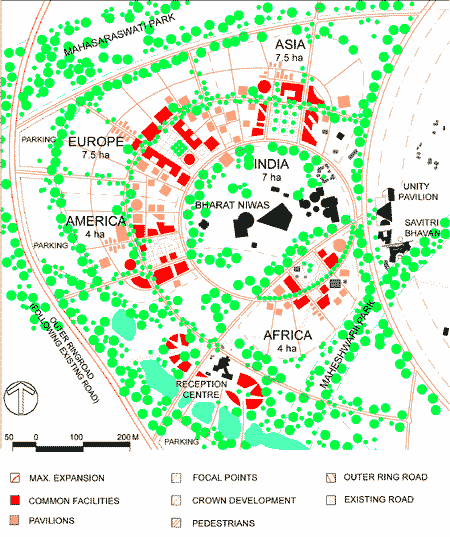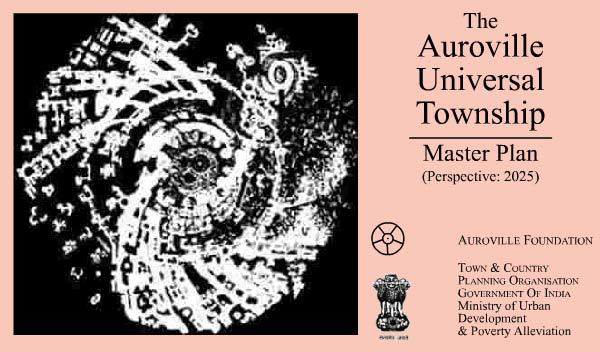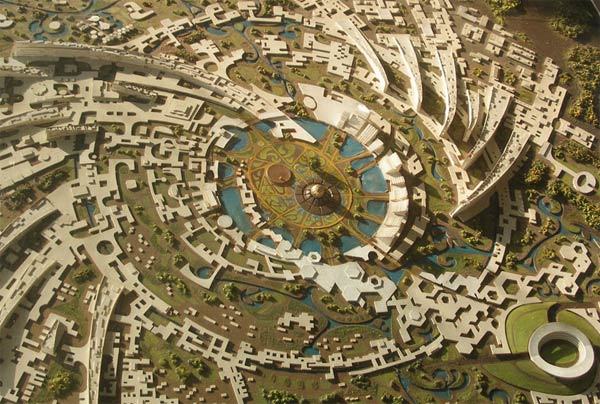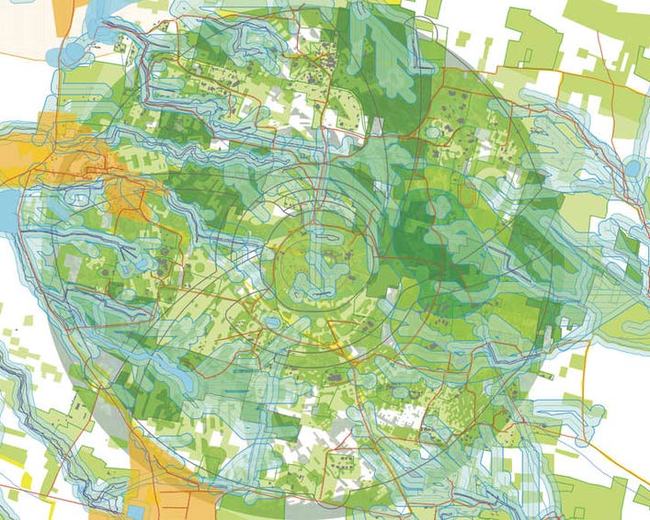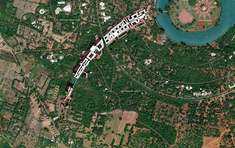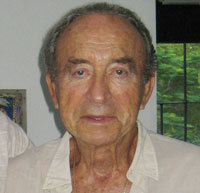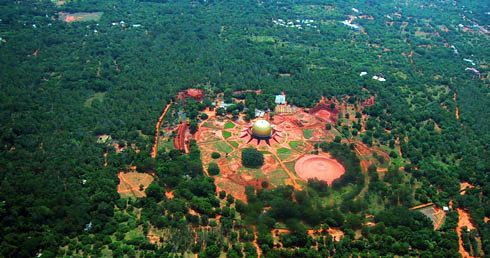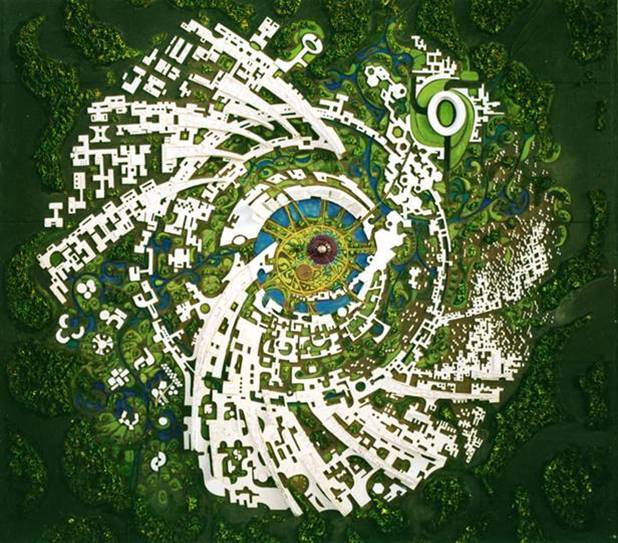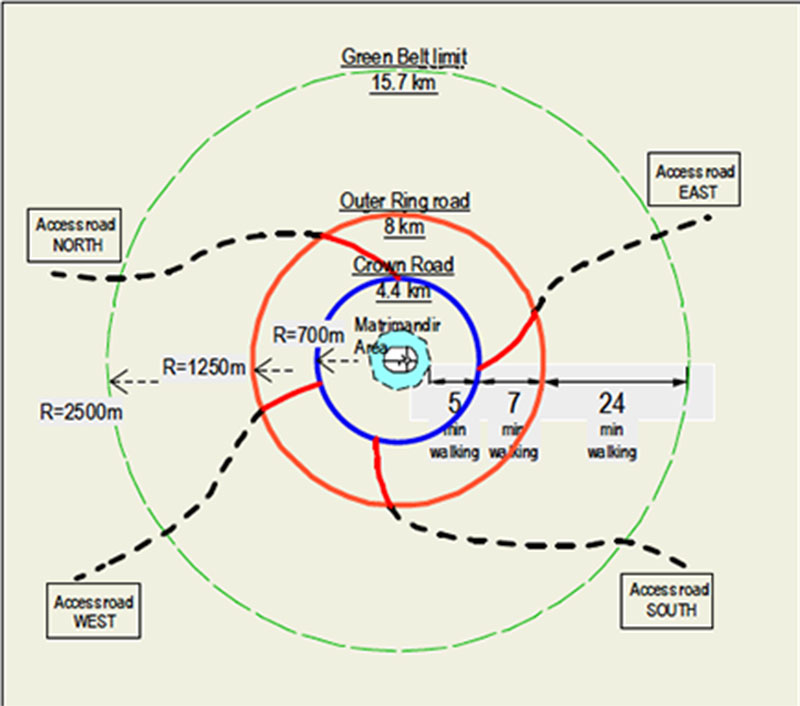Last updated:
Auroville International Zone - Planning and Development
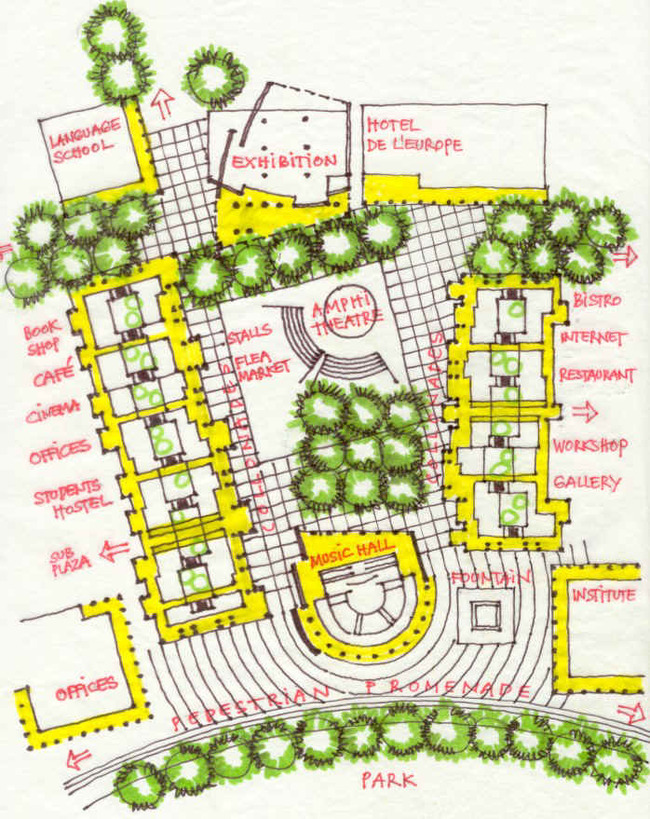
March 2001
The city as a development-model
Although the Mother has spoken of "a kind of permanent world-exhibition", her words make it very clear that this international educational centre is intended to be a very lively area, more like a 'cité universitaire' than a formal exhibition ground, a place where all the colourful cultures of the world can come together in a vibrant and progressive harmony.
The final size of the International Zone, its speed of growth, its contents, future life and requirements in the context of the whole of Auroville, depending on the extent of international participation, is unknown to us at present and rather difficult to assess.
Open-ended planning
This calls for a kind of open-ended planning. What is needed is not a 'frozen' master plan, but the postulation of a series of growth options, with the provision of possibilities for change. We should not try to enforce a fixed and pre-conceived end-picture.
Why not base the development of the International Zone on the structure and growth pattern of a city, a small town, a village or a neighborhood, expanding from a centre or square (surrounded by more significant or commonly-used buildings)? This would provide psychological well-being (through clear orientation and readability) and planning flexibility at the same time?
Categories of development
Four different types of development and participation in the International Zone can be identified so far:
A. Participation in the 'Unity Pavilion', a multipurpose complex within the 'Crown' (the chain-like development of institutional buildings along the ring-shaped 'Crown'-road at the centre of the township). The Unity Pavilion will be located next to the existing 'Savitri Bhavan' project.
This 'Unity'-project is the immediate next and first step to promote the International Zone and will contain exhibition spaces, offices, and guest accommodation as a service and forum for cultural groups who want to start activities.
B. Constructing an independent national or cultural pavilion, for instance the 'Russian Pavilion' or the 'Pavilion of the USA'.
C. Collective approaches - perhaps resembling projects such as the recently finished 'Scandinavian Embassies' complex in Berlin/Germany: a cluster of five buildings for the countries Finland, Sweden, Norway, Iceland and Denmark with an additional collective building for common use, each designed by a different architect. In the case of the Europeans for instance, such sub-groupings might be: Scandinavian culture, East-European culture, Mediterranean culture, French-German-Anglo-Saxon culture, etc.
D. First small beginnings in the form of a shop, a flat, a guesthouse etc. (As in Pondicherry there are hostels for groups from Orissa, Gujarat, Bengal; or the 'auberges' of different groups in Jerusalem, for example).
Each of these types of development should be allowed space within the International Zone's master plan. In this way, they can happen not only one after another but simultaneously, so as not to block or discourage any good effort or intention.
Urban web around focal points
To provide a coherent framework that would allow all these types of participation to find an appropriate place, the concept of an urban web developing around focal points is proposed.
-
The idea is to lay out four 'Focal Points' along a circle around Bharat Nivas for the cultural entities Europe, Asia (incl. Oceania), the Americas and Africa (incl. Middle East).
-
From these focal points development can start and move outward: it is the concept of the growth of a village or small town that takes place around a centre (village square or market place).
-
The emphasis is on allowing an organic process of orderly growth. It is a concept with a centre, which is supposed to provide identity and participation beyond the 'national cultural pavilion'.
The focal point for Europe, for example, could be the sort of colonnaded urban space that is found in so many European townships - the 'Agora' of the Greeks, the 'Forum' of the Romans, the Piazza or Place or Town Square - a very European concept of urban space.
The other cultural entities should find for themselves the form of centre they can identify with. Ideas that came up so far include 'campus' (America), 'village maidan' (Africa), 'walled mandala-garden' (Asia), etc.
Ideally, the principal focal point would be surrounded and defined by larger public and highly-frequented, shared buildings and facilities, such as halls for music, theatre, exhibitions and other events, libraries, restaurants, shops, etc., so as to create a lively public space and open air foyer, even and especially in the evenings.
A bazaar street?
The most difficult form of development to accommodate is probably category D, because of the smallness of a first groping step and the uncertainty of the future progress and finance. But those initial steps are most important and deserve encouragement, since a small seed may grow into a big tree. In a town-like concept, a street could easily be reserved for row-houses, shops, galleries etc. to accommodate those first small efforts. It could be a kind of bazaar-street well connected to the main town square (= focal point); then if the first step proves successful and new perspectives and financial means become available, an expansion in the form of a new and bigger 'plot' could be "acquired", and the old one either passed on to a 'beginner', or kept as a subsidiary. The concept of a urban web allows this easily.
The development areas
An area, in the Crown, just north of Savitri Bhavan, has been assigned to accommodate the Unity Pavilion. This multipurpose building, with shared spaces for individual as well as common use for any cultural group wanting to participate, will represent the International Zone as a landmark within Auroville's ring of institutional buildings called the 'Crown'.
-
The subcontinent of India has a special role, as the host of the whole of Auroville. The area of its cultural pavilions (with Bharat Nivas and the Tibetan Pavilion already established) are positioned in the centre of the International Zone. All buildings - even considering the most ambitious scenario - will be surrounded by greenery forming a kind of central park for the zone as a whole.
-
The other continental areas (with a total of 23 ha) are arranged in a circle around 'India', roughly in the sequence they appear on a world map. Each one has a central open area (to serve as a development node), to be surrounded by the most important buildings. Subdivision of the available areas is flexible and can be adapted according to need.
-
Asia in the northeast will allow for a maximal expansion to up to 7.5 ha. In this area the cultures of the Pacific countries as well as Australia are included.
-
Adjacent Europe will include Russia and is laid out for 7.5 ha maximally.
-
America can occupy up to 4 ha.
-
The area of Africa includes the cultures of the Middle East and amounts to 4 ha.
Density
Certain densities need to be fixed in order to monitor growth and to allow for future development; otherwise we may end up in an undesirable 'sprawl'.
If we assume an average building height of 2 storeys (envisaging 3 storeys around focal points and less than 2 storeys at the periphery), deduct half the area (for roads, green spaces, technical infrastructure etc.) and decide on an average ground coverage of 50%, the maximum built-up area would amount to half the area available (floor area ratio = 1.0).
Thus we arrive at 37 500 sqm. for Asia, 37 500 sqm. for Europe, 20 000 sqm. for America and 20 000 sqm. for Africa (built up gross area).
But these figures are only preliminary and need further and thorough discussion; they are only meant to give an idea of the dimension. A meaningful decision depends not only on questions of heights, densities or aesthetical concepts, but most of all on considerations of land-use, particularly the question of 'mixed usage', e.g. the extent to which Housing is allowed to be developed within the International Zone.
Visitors' Reception Centre
The International Zone can be considered the main 'gate' to Auroville. Visitors who are interested in Auroville should have a chance to make a first contact in info-centres located in Pondicherry, in Promesse on the Road to Chennai, as well as in Mudaliar Chavadi on the East Coast Road, before they arrive in the International Zone.
The existing Reception Centre - located between the areas of America and Africa - will have to be greatly enlarged to serve the function of a protective buffer to the interior of the township.
Circulation pattern
The International Zone is conceived as a pedestrian area with restricted access for motor vehicles.
From parking places along the Outer Ring Road visitors reach Auroville's Visitor's Reception Centre, which is conceived to be the showcase of Auroville and the contact place for people wishing to know more about Auroville, its background, people and activities.
In addition, some of the performances, facilities and exhibits that take place in the International Zone will be open to the public. From the Reception Centre the centres of the different continental sectors can be reached via shaded alleyways in a few minutes walking.
Aurovilians on their way to the International Zone will take the public transport system circling Matrimandir along the Crown Road, to arrive at a stopping point near the Unity Pavilion. From here it is only walking distance to reach all areas of the International Zone. Immediate neighbors in the Residential or Industrial Zone are connected directly.
Implementation process
After a decision on the general layout, land use and major circulation, design proposals should be invited for the four focal points, based on possible scenarios of future requirements.
This can be achieved by asking young architects from the different cultural areas, who best are able to express the spirit of their continent, to work on the design.
After approval a few development principles and bye laws need to be laid down (zoning, sequence and character of public spaces, heights, building types, choice of materials, etc.) as well as priority areas and -phases to be defined in each continental sector, for the different categories of development.
These parameters will be the base for the architect's work of detailed building design.
